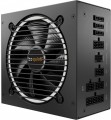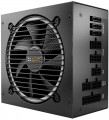Efficiency
Efficiency, in this case — the ratio of the power of the power supply (see "Power") to its power consumption. The higher the efficiency, the more efficient the power supply, the less energy it consumes from the network at the same output power, and the cheaper it is to operate. Efficiency may differ depending on the load; the characteristics can indicate both the minimum efficiency and its value at an average load (50%).
It should be noted that compliance with one or another level of 80PLUS efficiency directly depends on this indicator (for more details, see "Certificate").
ATX12V version
A standard for power supplies that supplements the ATX specifications regarding power supply along the 12 V line. Introduced into use since the time of the Intel Pentium 4 processor. In the first series of the standard, the +5 V line was mainly used; from version 2.0, the +12 V line was introduced to fully power the components computer. Also in the second generation, a 24-pin power connector appeared, used in most modern motherboards.
MB/CPU power supply
The number and type of connectors provided in the PSU to power the motherboard or processor.
This parameter is written as the sum of several numbers, for example, "24+4". The first number in such an entry means the number of contacts in the connector for powering the motherboard; in the vast majority of cases, this is just 24, since modern motherboards use a 24-pin connector as standard. The second number describes the socket for powering the processor; most entry-level and mid-range CPUs use 4-pin power, but powerful chips may require 8-pin power. There can be several 4- or 8-pin connectors — based on powerful high consumption processors.
A separate case is the blocks of the "24 (20 + 4)" format. They have two separate plugs — 20 pin and 4 pin, which allows you to power both 24-pin motherboards and older 20-pin motherboards from such power supplies. At the same time, such models do not provide a separate power supply for CPU — it is powered only through the socket, and the 4-pin plug cannot be connected to any other components except the motherboard.
Now on the market there are PSUs with such power supply for the motherboard:
24 pin (20+4),
24+4 pin,
24+8(4+4) pin,
24+8+8(4+4) pin.
SATA
The number of SATA power connectors provided in the PSU.
Nowadays, SATA is the standard interface for connecting internal hard drives, and it is also found in other types of drives (SSD, SSHD, etc.). Such an interface consists of a data connector connected to the motherboard, and a power connector connected to the PSU. Accordingly, in this paragraph we are talking about the number of SATA power plugs provided in the PSU. This number corresponds to the number of SATA drives that can be simultaneously powered from this model.
PCI-E 8pin (6+2)
The number of PCI-E 8pin (6+2) power connectors provided in the PSU design.
Additional PCI-E power connectors (all formats) are used to additionally power those types of internal peripherals for which 75 W is no longer enough, supplied directly through the PCI-E socket on the motherboard (video cards are a typical example). In PC components, there are two types of such connectors — 6pin, providing up to 75 W of additional power, and 8pin, giving up to 150 W. And the 8pin (6 + 2) plugs used in power supplies are universal: they can work with both 6-pin and 8-pin connectors on the expansion board. Therefore, this type of plug is the most popular in modern PSUs.
As for the quantity, on the market you can find models
for 1 PCI-E 8pin (6 + 2) connector,
for 2 such connectors,
for 4 connectors, and in some cases —
for 6 or more. Several of these plugs can be useful, for example, when connecting several video cards — or for a powerful high-performance video adapter equipped with several PCI-E additional power connectors.
PCI-E 16pin
the 16-pin PCI-E power connector is designed to replace the existing 8-pin counterparts. It consists of twelve lines for current supply and four more for data transmission. The connector provides up to 600 W of additional power, which is a fourfold increase in power compared to 8-pin versions of the interface. Additional PCI-E connectors of all formats are used to power those types of internal peripherals that are no longer enough with 75 W supplied directly through the PCI-E socket on the motherboard.
Floppy
The presence of at least one Floppy power connector in the PSU.
Initially, this connector was intended to power floppy disk drives, hence the name. It is also known under the designation "mini-Molex". Anyway, this standard is generally considered obsolete, but it is still used by some specific types of components, and therefore continues to be used in power supplies.
Protection
Protection circuits provided in the power supply. In addition to the OVP (overvoltage protection), OPP (overcurrent/power protection), and SCP (short circuit protection) described above, modern PSUs may include the following safety features:
— O.C.P. Overload protection on individual power outputs. It differs from OPP in that it takes into account not the total current consumption, but the current at each output separately.
— UVP. Undervoltage protection at the output of the power supply. For some components, such a voltage is as undesirable as an increased voltage: for example, a hard drive at reduced power cannot spin the plates to the required speeds. Usually, UVP is activated when the voltage drops by 20 – 25%.
— OTP. Protection against overheating of individual components of the power supply.
— SIP. Protection against voltage surges and surges is, in fact, a built-in stabilizer that can smooth out these surges to a certain extent. This feature does not eliminate the need for an external stabilizer, but it improves the overall performance of the protection.
— A.F.C. Not so much a protective as an “energy saving” function: automatic fan speed control, which allows you to change the speed depending on the load and the actual heat dissipation of the PSU. In addition to saving energy, this adjustment also reduces wear on the moving parts of the cooler.
— C.E. Power supply complies with European Union dire...ctives for energy efficiency and safety.
— CB. Power supply complies with IEC (International Electrotechnical Commission) directives regarding the safety of electrical equipment and components.
— FCC. Power supply complies with FCC (Federal Communications Commission) directives, especially regarding electromagnetic interference.
— CCC. Compliance of the power supply with the requirements necessary for official certification in the Chinese market (PRC).
— K.C. Compliance of the power supply with the requirements necessary for official certification in the South Korean market.
— BSMI. Compliance of the power supply with the requirements required for official certification in the Taiwan market.
— RCM. Power supply meets the requirements for official certification in the Australian and New Zealand market. RCM requirements are primarily concerned with safe use and electromagnetic compatibility.
— TUV-RH. Power supply meets the criteria for certification by TÜV Rheinland Group, one of the world's largest and most respected auditing and certification companies. Most often, we are talking about the TÜV-Mark Approval certificate, which indicates that the individual parts of the device (body, boards, parts, switches, etc.) comply with the requirements for safe use.
— cTUVus. Another certification held by the above mentioned TÜV Rheinland Group. In this case, we are talking about the compliance of the power supply with the technical requirements necessary for admission to the markets of the USA and Canada. The cTUVus certificate has the same legal validity as certificates issued directly by the authorities in those countries.
— EAC. Compliance of the power supply with the technical requirements of the Eurasian Economic Union (former Customs Union).
Noise level
The noise level produced by the power supply.
Usually, the characteristics indicate the average value of the noise level during normal operation. The lower this value, the quieter the power supply and the more comfortable it is to use. However, it is worth noting that modern computer PSUs produce very little noise. So, in the quietest models, this figure
does not exceed 20 dB — this is no louder than the rustling of leaves in a light breeze, such a sound is almost inaudible and is quite acceptable even in a residential area at night. Also acceptable for this application are noise sources of
21 – 25 dB(corresponding to a whisper at a distance of about 1 m) and
26 – 30 dB(wall clock ticking). Noise
of more than 30 dB is already considered quite significant for computer PSUs; according to sanitary standards, such equipment in residential premises can only be used during the day.
When choosing a power supply for this indicator, it is worth considering a few points. First, noise reduction comes at a cost: it can affect the cooling performance and/or cost of the device. Secondly, the noise from the power supply is often lost against the background of louder PC components — for example, powerful cooling systems for the CPU or graphics card. Thirdly, the very environment where the PC is installed can be noisy — an example is a
...n office or coworking. Thus, specifically looking for a low-noise model makes sense mainly in cases where maximum silence is crucial for you.
